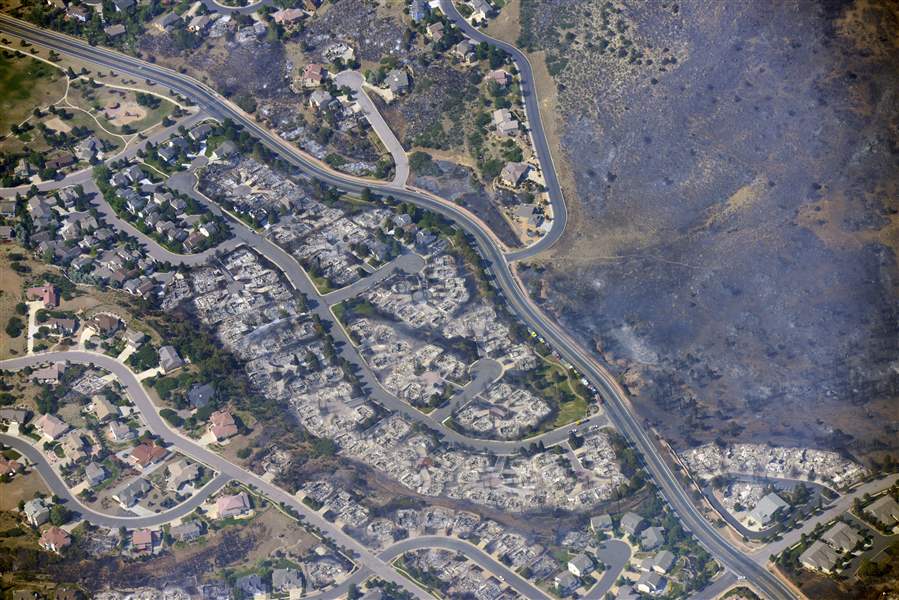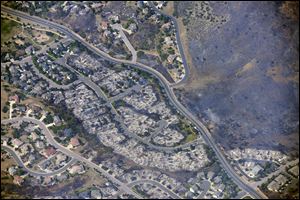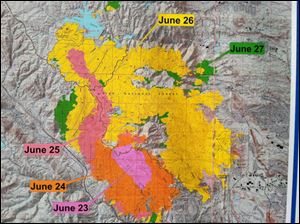
Mayor: Colorado Springs fire destroys estimated 346 homes
Waldo Canyon fire most destructive in state history
6/28/2012
This aerial photo taken on Wednesday shows burned homes in the Mountain Shadows residential area of Colorado Springs, Colo., that were destroyed by the Waldo Canyon wildfire.
ASSOCIATED PRESS

This aerial photo taken on Wednesday shows burned homes in the Mountain Shadows residential area of Colorado Springs, Colo., that were destroyed by the Waldo Canyon wildfire.
COLORADO SPRINGS, Colo. — A raging Colorado wildfire destroyed an estimated 346 homes this week, making it the most destructive fire in the state’s history, officials said.
Colorado Springs Mayor Steve Bach said city officials assessed the damage and that the number was subject to change.
From above, the destruction wrought by the fire becomes painfully clear: Rows and rows of houses — hundreds in all — were reduced to ashes even as some homes just feet away survived.
On one street, all but three houses had burned to their foundations, said Ryan Schneider, whose home is still standing in a neighborhood where 51 others were destroyed.
“I was real happy at first. My wife was happy,” he said. “The emotion of seeing the other homes, though, was instant sadness.”
While the aerial photos helped show the scope of one of the worst fires to hit the American West in decades, they did little to help ease the concerns of many residents who still did not know the fate of their properties.
“Naturally, we’re apprehensive and the spirit is down a little bit,” Bill Bartlett said outside a Red Cross shelter in Colorado Springs. He believes his neighborhood was spared, but couldn’t be sure.
Amid the devastation in the foothills west and north of the state’s second-largest city, there were hopeful signs. More than 120 soldiers helped stop flames advancing on the U.S. Air Force Academy and cooler conditions could help slow the spread of a fire that could become one of the most destructive in state history.
Authorities initially did not know the extent of the damage, saying it was difficult to assess because the fires and smoke were too intense. More than 30,000 people frantically packed up belongings Tuesday night as the flames swept through their neighborhoods.
Community officials were planning to begin the process of notifying residents Thursday that their homes were destroyed. They planned to schedule meetings for residents of different streets to advise them personally that their homes have been destroyed.
Officials had not released such lists as of Thursday afternoon.
But for many residents, the official notification is a formality. Residents recognize their street on aerial pictures taken of the devastation and carefully scrutinize the images to determine the damage.
Aerial photos and video from The Associated Press and the Denver Post showed widespread damage.

The latest burn perimeter map of the Waldo Canyon wildfire in Colorado Springs, Colo. The green area is what burned on June 27th, yellow is from June 26th, etc.
Colorado Springs, about 60 miles south of Denver, is also home to the U.S. Olympic Training Center, NORAD and the Air Force Space command, which operates military satellites. They were not threatened.
Conditions were still too dicey to allow authorities to begin trying to figure out what sparked the blaze that has raged for much of the week and already burned more than 29 square miles.
President Barack Obama was to tour fire-stricken areas on Friday as hundreds of locals and some tourists who were staying at Red Cross shelters hoped life would return to normal soon. Many more stayed with friends and family.
The evacuated area is a mix of apartment complexes, single-family homes, hotels and developments such as technology parks, said Joe Raso, president of the Colorado Springs Chamber of Commerce.
Bret Waters, the city’s emergency management director, said officials know people displaced by the blazes face hardships but urged patience.
“Being evacuated on the long-term is difficult. So as you prepare to evacuate, you need to think about, not just a day or two, but think a week or two weeks. What would you do out of your home for two weeks?” he said.
The weather forecast offered some optimism for firefighters to make progress, with the temperature expected to reach into the mid-80s — about 5 degrees cooler than Wednesday — and humidity 15 to 20 percent, about 5 points higher. Winds were forecast to be 10 to 15 mph.
As of mid-day Thursday, the fire was only 10 percent contained. The cost of fighting the blaze had already reached $3.2 million.
The fire blackened up to 50 acres along the southwest boundary of the Air Force Academy campus, said Anne Rys-Sikora, a spokeswoman for the firefighters. No injuries or damage to structures — including the iconic Cadet Chapel — were reported.
Fort Carson, an Army infantry post about 15 miles from the academy, sent 120 soldiers along with bulldozers and other heavy equipment to help clear a line to stop the fire on the academy. Rys-Sikora said the academy was not getting a disproportionate share of equipment and firefighters.
The Flying W Ranch, a popular tourist attraction near Colorado Springs, was severely damaged in the blaze. But authorities let people into the area to check on cattle. John Hendrix, who volunteers at the Flying W, said 47 animals were accounted for.
“Some of them are pretty scorched up, but they are still there. We didn’t lose one,” Hendrix said.
Among the fires elsewhere in the West:
— A 72-square-mile wildfire in central Utah has destroyed at least 56 structures and continues to burn with just 15 percent containment, authorities said. Officials expected the damage estimate to rise as they continue their assessment.
— The smaller fire near St. George started Wednesday and had grown to 2,000 acres by midnight, forcing some residents to evacuate. The fire was burning about three miles north of Zion National Park. At least eight structures were destroyed.
— Fire crews in southeastern Montana used a break in the weather to dig containment lines around two wildfires that have burned 200 square miles and dozens of homes. The improved conditions led to residents clamoring to be let back in to check their properties and assess the damage, but authorities kept evacuation orders in place for hundreds of people.
— A wildfire in the Bridger-Teton National Forest has grown from about 12,000 acres to 23,000 acres, or nearly 36 square miles, officials said.
— In northern Colorado, about 1,900 people were being allowed back into their homes Thursday more than two weeks after a devastating fire erupted. The fire killed one woman and destroyed 257 homes, a state record.